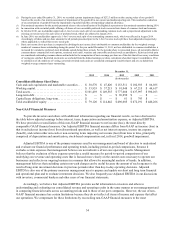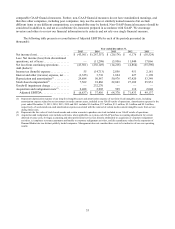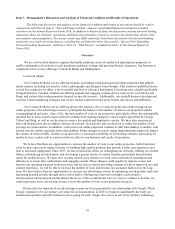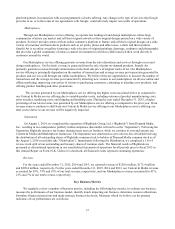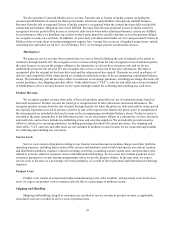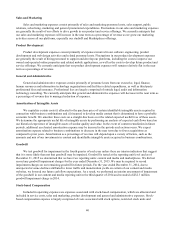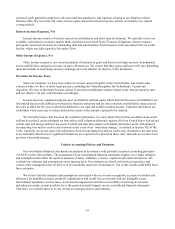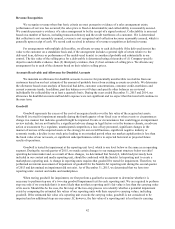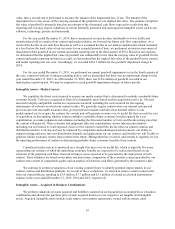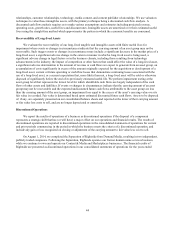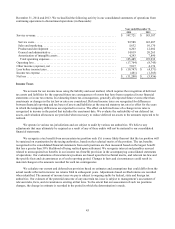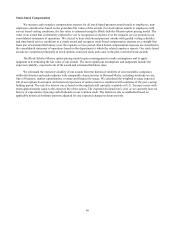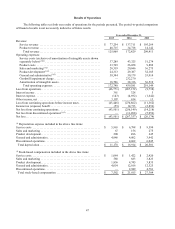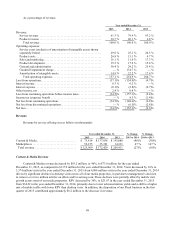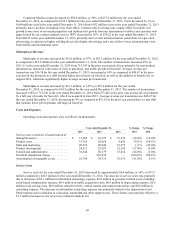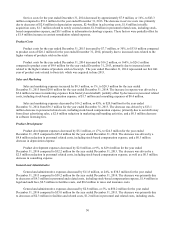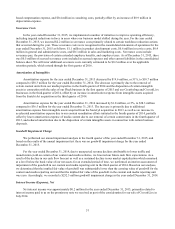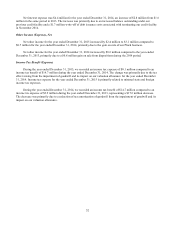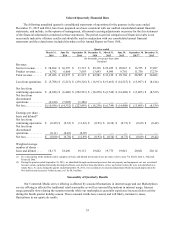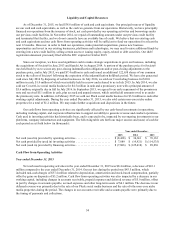Enom 2015 Annual Report Download - page 46
Download and view the complete annual report
Please find page 46 of the 2015 Enom annual report below. You can navigate through the pages in the report by either clicking on the pages listed below, or by using the keyword search tool below to find specific information within the annual report.44
relationships, customer relationships, technology, media content, and content publisher relationships. We use valuation
techniques to value these intangibles assets, with the primary technique being a discounted cash flow analysis. A
discounted cash flow analysis requires us to make various assumptions and estimates including projected revenue,
operating costs, growth rates, useful lives and discount rates. Intangible assets are amortized over their estimated useful
lives using the straight-line method which approximates the pattern in which the economic benefits are consumed.
Recoverability of Long-lived Assets
We evaluate the recoverability of our long-lived tangible and intangible assets with finite useful lives for
impairment when events or changes in circumstances indicate that the carrying amount of an asset group may not be
recoverable. Such trigger events or changes in circumstances may include: a significant decrease in the market price of a
long-lived asset, a significant adverse change in the extent or manner in which a long-lived asset is being used, a
significant adverse change in legal factors or in the business climate, including those resulting from technology
advancements in the industry, the impact of competition or other factors that could affect the value of a long-lived asset,
a significant adverse deterioration in the amount of revenue or cash flows we expect to generate from an asset group, an
accumulation of costs significantly in excess of the amount originally expected for the acquisition or development of a
long-lived asset, current or future operating or cash flow losses that demonstrate continuing losses associated with the
use of a long-lived asset, or a current expectation that, more likely than not, a long-lived asset will be sold or otherwise
disposed of significantly before the end of its previously estimated useful life. We perform impairment testing at the
asset group level that represents the lowest level for which identifiable cash flows are largely independent of the cash
flows of other assets and liabilities. If events or changes in circumstances indicate that the carrying amount of an asset
group may not be recoverable and the expected undiscounted future cash flows attributable to the asset group are less
than the carrying amount of the asset group, an impairment loss equal to the excess of the asset’s carrying value over its
fair value is recorded. Fair value is determined based upon estimated discounted future cash flows. Assets to be disposed
of, if any, are separately presented on our consolidated balance sheets and reported at the lower of their carrying amount
or fair value less costs to sell, and are no longer depreciated or amortized.
Discontinued Operations
We report the results of operations of a business as discontinued operations if the disposal of a component
represents a strategic shift that has (or will have) a major effect on our operations and financial results. The results of
discontinued operations are reported in discontinued operations in the consolidated statements of operations for current
and prior periods commencing in the period in which the business meets the criteria of a discontinued operation, and
include any gain or loss recognized on closing or adjustment of the carrying amount to fair value less cost to sell.
On August 1, 2014, we completed the Separation of Rightside from Demand Media, resulting in two independent,
publicly traded companies. Following the Separation, Rightside operates our former domain name services business,
while we continue to own and operate our Content & Media and Marketplaces businesses. The financial results of
Rightside are presented as discontinued operations in our consolidated statements of operations for the years ended


